Archive : Article / Volume 1, Issue 1
Case Report | DOI: https://doi.org/10.58489/2833-0951/001
Cancers in Iraq: Half century overview
Advisor doctor, Children Teaching Hospital of Baghdad Medical City and the National Training and Development Center.
Correspondng Author: Aamir Jalal Al-Mosawi
Citation: Aamir Jalal Al-Mosawi (2022). Cancers in Iraq: Half century overview. Biomedical and Biotechnological Sciences. 1(1). DOI: 10.58489/2833-0951/001
Copyright: © 2022 Aamir Jalal Al-Mosawi, this is an open access article distributed under the Creative Commons Attribution License, which permits unrestricted use, distribution, and reproduction in any medium, provided the original work is properly cited.
Received Date: 2022-07-14, Received Date: 2022-07-14, Published Date: 2022-08-01
Abstract Keywords: Malignant diseases, Iraq, patterns.
Abstract
Malignancies have been increasingly regarded as one of the main challenges to healthcare systems throughout the world. Malignant diseases were reported by the World Health Organization to be the second leading cause of death throughout the world accounting for about sixth of all deaths during the year 2018. There has been increasing interest in the historic patterns of malignant disease which can help in establishing understanding of the possible changes of pattern of cancer. The aim of this paper is to provide an overview of the pattern of malignancy in Iraq during the previous half century.
The top five cancers reported in Iraq during ten-year period (1976-1985) were different from the top cancers throughout the world as reported by the World Health Organization during the previous years. The pattern of malignant disease in Iraq during the years 2000 to 2004 was rather different from the pattern of malignancies in other countries like United States of America. The incidence rate of new cases of malignancies were increasing during the previous decades as it was 38.91/100,000 population in 1994, 52.8\100,000 in 2006, and 82.62/100,000 population in 2018. The pattern of cancers in Iraq was not very similar to the latest global pattern reported by the World Health Organization. In addition, the pattern of childhood cancers in Iraq witnessed some changes during the previous decades.
THE PATTERN OF MALIGNANCY IN IRAQ (1976-1985)
During ten-year period (1976-1985), 35416 new patients (20941 males and 14475 females) with malignant disease were recorded by the Iraqi Ministry of health including 3591 (2193 males and 1398 females) in 1976, 4111 (2488 males and 1623 females) in 1977, 4145 (2490 males and 1655 females) in 1978, 3339 (1997 males and 1342 females) in 1979, 3087 (1869 males and 1218 females) in 1980, 3387 (1975 males and 1412 females) in 1981, 2872 (1716 males and 1156 females) in 1982, 3074 (1776 males and 1298 females) in 1983, 3903 ( 2201 males and 1702 females) in 1984, and 3907 ( 2236 males 1671 and females) in 1985 [1,2,3,4].
The incidence of malignancy in Iraq during the ten-year period was rather fluctuating as it was not consistently increasing nor decreasing. Figure-1A shows the incidence of malignancy in Iraq (1976-1985) per 100000 populations based on population estimation at https://www.macrotrends.net/countries/IRQ/iraq/population
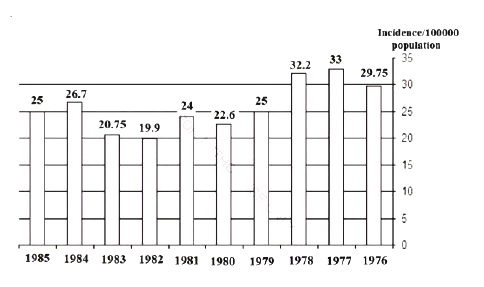
Urinary bladder cancer was the most common cancer during the ten-year period accounting for 10.2% of all registered cancers, and it was the most common cancer in male, but it ranked fourth among the most common cancers in females. Breast cancer ranked second among the most common cancers, accounting for 8.31% of all registered cancers, and it was number one cancer in females. Lung and bronchial cancer was third most common cancer accounting for 8.3% of all registered cancers, but it ranked second among the most common cancers in males.
Skin cancer including melanoma was fourth most common cancer accounting for 8.2% of all registered cancers, but it ranked second most common cancers in females.
Cancer of the larynx was the fifth most common cancer accounting for 6% of all registered cancers, and it was the fourth most common cancer in males. Table-1 shows the 20 most common malignancies in Iraq during the ten-year period [1.2.3.4].
Number | Male | Female | |
| Urinary bladder | 3607 | 2715 | 892 |
| Breast | 2943 | 76 | 2867 |
| Lung and bronchus | 2941 | 2503 | 438 |
| Skin cancer including melanoma | 2908 | 1762 | 1146 |
| Larynx | 2169 | 1634 | 535 |
| Leukemia | 2162 | 1346 | 816 |
| Non-Hodgkin lymphoma | 1750 | 1161 | 589 |
| Stomach | 1411 | 948 | 463 |
| Colon and rectum | 1162 | 701 | 461 |
| Hodgkin lymphoma | 1085 | 746 | 339 |
| Brain and nervous system | 980 | 584 | 396 |
| Uterus and cervix | 909 | _ | 909 |
| Connective and soft tissue | 782 | 497 | 285 |
| Thyroid and other endocrine glands | 778 | 332 | 446 |
| Bone | 604 | 377 | 227 |
| Esophagus | 559 | 377 | 182 |
| Pancreas | 497 | 314 | 183 |
| Liver | 490 | 359 | 131 |
| Hypopharynx and pharynx | 478 | 244 | 234 |
| Renal | 469 | 295 | 174 |
Table-1: The 20 most common malignancies in Iraq during the ten-year period
Malignancies were reported by the World Health Organization as the second leading cause of death throughout the world accounting for about sixth of all deaths during the year 2018. The World Health Organization reported that lung, prostate, colorectal, stomach and liver cancers as the most common types of cancer in males in the world, while breast, colorectal, lung, cervical and thyroid cancers were considered the most common in females in the world. The top five cancers reported in Iraq during ten-year period (1976-1985) were different from the top cancers throughout the world as reported by the World Health Organization during the previous years (Figure-1B) [1, 2, 3, 4].
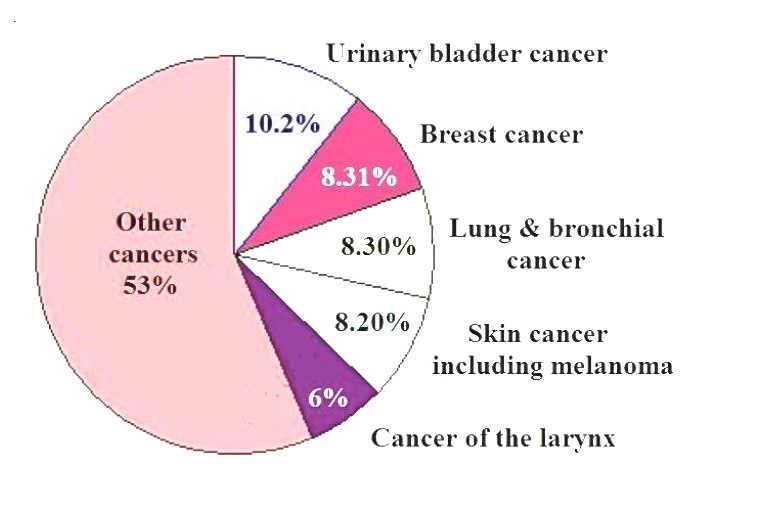
THE PATTERN OF MALIGNANCY IN IRAQ (2000-2004)
Malignant diseases have become a major challenge to the healthcare system in Iraq. It is estimated that malignant disease accounts for 5.6% of all deaths in Iraq. during five-year period (2000-2004), 63923 Iraqi patients with various types of newly diagnosed cancer registered by the Iraqi Ministry of Health from all Iraqi provinces with exception of 3 Northern provinces (Sulaimanyia, Erbil, and Dohouk). Breast cancer ranked first and accounted for 16% of all Iraqi patients with malignant disease.
Malignancies of the lungs ranked second and accounted for 8% of all malignant disease in Iraq, but they ranked first in Iraq males’ patients with malignant diseases. Leukemia was the third most common malignant disease in Iraq accounting for 7% of all malignancies. Table-2A shows the type of malignancies in Iraq by primary tumor site.
The four most common malignancies among males were lung and bronchus malignancies, bladder malignancies, leukemias and non-Hodgkin lymphoma accounting for about 37.7% of all malignancies in males [5-6].
| Type of malignancies | Total number | Number in males | Number in females |
| Breast malignancies | 10277 | 464(4.5%) | 9813(95.5%) |
| Lung & bronchus malignancies | 5157 | 4105(79.6%) | 1052(20.4%) |
| Leukemias | 4476 | 2618(58.5%) | 1858(41.5%) |
Bladder malignancies | 4253 | 3250(76.4%) | 1003(23.6%) |
| Brain & CNS malignancies | 3871 | 2217(57.3%) | 1654(42.7%) |
NHL | 3782 | 2283(60.4%) | 1499(39.6%) |
| Colorectal malignancies | 2736 | 1545(56.5%) | 1191(43.5%) |
Malignancies of larynx | 2590 | 1998(77%) | 592(23%) |
Skin malignancies excluding Melanoma | 2425 | 1342(55.4%) | 1083(44.6%) |
Stomach malignancies | 2108 | 1246(59%) | 862(41%) |
| Reproductive organs malignancies | 1692 | _ | 1692 |
| Hodgkin disease | 1502 | 925(61.6%) | 577(38.4%) |
| Thyroid malignancies | 1334 | 446(33.4%) | 888(66.6%) |
| Malignancies of kidney, pelvis & ureter | 1232
| 754(61%) | 478(39%) |
| Malignancies of ovary | 1203 | _ | 1203 |
| Prostate malignancies | 1081 | 1081 | _ |
| Pancreas malignancies | 1014 | 575(56.7%) | 439(43.3%) |
| Bone & cartilage malignancies | 999 | 58.7(58.8%) | 412(41.2%) |
| Liver &bile ducts malignancies | 637 | 358(56%) | 279(44%) |
Esophagus malignancies | 539 | 342(63.5%) | 197(36.5%) |
Table-2A: The type of malignancies in Iraq by primary tumor site
The four most common malignancies among females were malignancies of the breast, leukemias, malignancies of reproductive organs (uterus including cervix and corpus), and malignancies of brain and CNS, accounting for about 47.5% of all malignancies in females. Breast malignancies accounted for 31% of all new malignant disease among females.
The pattern of malignant disease in Iraq was rather different from the pattern of malignancies in other countries like United States of America. The four most commonly diagnosed types of malignant disease among males in the United States of America were malignancies of the prostate, lung and bronchus, colon and rectum, and bladder, accounting for about 57% % of malignant disease in males [5,6].
The four most commonly diagnosed types of malignancies among females in the United States of America were malignancies of the breast, lung and bronchus, colon and rectum, and uterine corpus, accounting for about 56 % of malignancies in females. Malignancies of the lung and bronchus was the second leading cause of malignancies in the United States of America accounting for 15% of all newly diagnosed malignancies in females. Malignancies of the lung and bronchus in United States of America females accounted for a higher percentage than Iraqi males. This difference was attributed to the high incidence of smoking in females in the United States of America. Malignancies of the prostate were the leading cause malignancies in males in the United States of America accounting for 29% of the newly diagnosed cases. In Iraq malignancies of the prostate was the tenth leading cause malignant disease in males accounting for 3.3% of the newly diagnosed cases in males. The continued increase in the incidence of prostatic malignancies in United States of America has been attributed to screening with prostate-specific antigen testing.
The most common form of malignancies in Europe were malignancies of the breast accounting for 13.5% of all malignant disease, followed by colorectal malignancies (12.9%) and lung malignancies (12.1%). In Nigeria cancers of the cervix (22.9%), breast (18.9%), ovary (8.2%), non-melanoma skin cancer (6.3%), and uterus (6.2%) were the most frequent female cancers. In males, cancer of the prostate (16.5%), bladder (10.2%), non-melanoma skin (9.9%), colorectal (9.3%) and connective tissue (6.3%) were most common. Cancer in Africa was not only different from the cancer pattern in Iraq but also differs from the pattern observed in USA and Europe.
During five-year period (2000-2004), 10277 cases of breast cancer including 464 males (4.5%), and 9813 females (95.5%) were recorded by the Iraqi Ministry of Health. 7876 cases (76.6%) had the histology of Infiltrating duct carcinoma (IDC) not otherwise specified (NOS), which was found to be the most common type. The second most common histopathological type was infiltrating lobular carcinoma which occurred in 562 cases (5.46 %), while the third most common histological type was adenocarcinoma carcinoma which occurred in 558 cases (5.43%). Epithelial carcinoma occurred 145 in cases (1.4%), medullary carcinoma occurred in 114 in cases (1.1%), and Comedo carcinoma occurred in 67 (0.65%).
The histopathological cancer pattern of breast cancer in Iraq (2000-2004) was different from the previously reported pattern in Asian and African countries such as India and Nigeria. The commonest histological types of breast cancer in Nigerian women in a study conducted over a twelve-year period (January 1993-December 2004) were IDC (not otherwise specified) constituted the majority of breast cancer accounting for 75.5%, while papillary carcinoma was the least common (2.7%). Ductal carcinoma in situ accounted for 6.6% [5.6].
In 569 Indian female breast cancers, there were 502 cases (88.2%) with histology of IDC not otherwise specified (NOS), which was found to be the most common type. This was followed in decreasing order by infiltrating lobular carcinoma in 21 cases (3.7%), colloid carcinoma in 6 cases (1.1%), ductal carcinoma-in-situ in 6 cases (1.1%), metaplastic type in 5 cases (0.9%), schirrous carcinoma in 5 cases (0.9%), apocrine type in 4 cases (0.7%) and the rest 20 cases (3.5%) with other types of carcinomas.
During five-year period (2000-2004), 5157 cases of lung cancers (4105 males, 1052 females) were recorded by the Iraqi Ministry of Health from all Iraqi provinces with the exception of 3 Northern provinces (Sulaimanyia, Erbil, and Dohouk). The commonest histopathological types of lung cancer as shown in table-2B were squamous cell carcinoma accounting for 37.6% of the cases, adenocarcinoma accounting for 13% of the cases, small cell carcinoma accounting for 8.3% of the cases, and large cell carcinoma accounting for 7 % of the cases [5,6].
| Histopathology | Number (%) |
| Squamous cell carcinoma | 1940 (37.6%) |
| Adenocarcinoma | 672 (13 %) |
| Small cell carcinoma | 428 (8.3%) |
| Large cell carcinoma | 361 (7%) |
| Epithelial tumor | 240 (4.65%) |
| Oat cell carcinoma | 130 (2.5%) |
| Carcinoma, undifferentiated | 89 (1.7%) |
| Carcinoid tumor | 19 (0.36%) |
| Carcinoma, Anaplastic | 15 (0.3%) |
Table-2B: The commonest histopathological types of lung cancer in Iraqi patients (2000-2004)
In addition, there were 29 cases of tracheal cancer; histopathology is shown in table-2C. For every 178 cases of lung cancer there was one case of tracheal cancer. There were also 31 cases of pleural cancer mesothelioma.
| Histopathology | Number |
| Squamous cell carcinoma | 19 |
| Small cell carcinoma | 4 |
| Adenocarcinoma | 3 |
| Large cell carcinoma | 1 |
| Carcinoma, undifferentiated | 1 |
| Squamous small cell carcinoma | 1 |
Table-2C: The histopathological types of tracheal cancer in Iraqi patients (2000-2004)
Geographical differences have been reported in the incidence of various histological pattern of lung cancer. Shifts in histological tumor type distribution, chiefly an increase in adenocarcinoma, have been reported to accompany changes in lung cancer incidence during the last two decades in the United States and several other developed countries. In Europe, the squamous cell type was predominating and an increase in incidence of adenocarcinoma has only been reported in the Netherlands. In Asia, in the 1960s and 1970s, the proportion of adenocarcinoma was higher than in North America or Europe and seems to be increasing.
In Iraqi patients with lung cancer, the changes in the incidence of squamous cell carcinoma and adenocarcinoma during a five year-period (2000-2004) were very similar. Figure-2A shows the number of cases of both histological types during the five-year period (2000-2004) [5, 6].
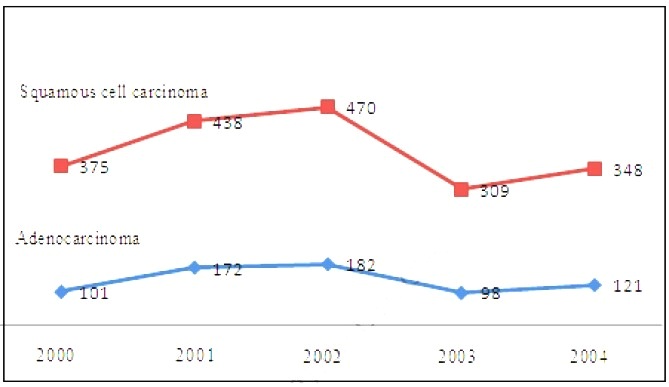
Therefore, the shifts in histological cancer type distribution, chiefly an increase in adenocarcinoma, has been reported to accompany changes in lung cancer incidence in the last two decades in the United States and several other developed countries were not observed in this large sample of Iraqi patients with lung cancer recorded over a five-year period (2000-2004).
During five-year period (2000-2004), 10330 cases of the commoner hemopoeitic and lymphoreticuar malignancies (leukemia, lymphoma, and multiple myeloma) were recorded by the Iraqi Ministry of Health from all Iraqi provinces with the exception of 3 Northern provinces (Sulaimanyia, Erbil, and Dohouk).
Acute lymphoblastic leukemia was the commonest histopathology of leukemias accounting for 41.5% of all cases. Acute myeloid leukemia was the second most common histopathology accounting for 20.5%. Chronic Myeloid leukemia was the third most common histopathology accounting for 11.4%. Table-2D shows the frequency of various leukemias histopathology [5, 6].
| Histopathology | Number (%) |
| Acute lymphoblastic | 1856(41.5%) |
| Acute myeloid | 917 (20.5%) |
| Chronic Myeloid | 509 (11.4%) |
| Chronic lymphoid | 302 |
| Myeloid | 50 |
| Hairy cell | 29 |
| Lymphoid | 15 |
| Acute monocytic | 15 |
| Acute promyelocytic | 12 |
| Eosinophilic | 3 |
| Erythroleukemia | 3 |
| Acute myelomonocytic | 2 |
| Mast cell | 2 |
| Adult T-cell leukemia/lymphoma | 2 |
| Subacute Myeloid | 2 |
| Lymphosarcoma cell | 2 |
| Basophilic | 2 |
Table-2D: The frequency of various leukemias histopathology in Iraq (2000-2004)
During the years 2000 to 2004, and in contrast to many western countries where the incidence rate of non-Hodgkin's lymphomas (NHL) was increasing, while trends for the other hematolymphopoietic were strikingly stable, the incidence rate of leukemias was increasing while trends for the other hematolymphopoietic malignancies were strikingly stable (Figures 2B,2C, and 2D).
During five-year period (2000-2004), 2585 cases of skin cancers were recorded in all age groups by the Iraqi Ministry of Health from all Iraqi provinces with the exception of 3 Northern provinces (Sulaimanyia, Erbil, and Dohouk). A total of 2425 non-melanoma skin cancers were recorded including 1342 cases in males and 1083 cases in females. 17 cases occurred in children under 5 years of age. The average annual incidence of non-melanoma skin cancers was 2.20 /100.000 population. A total of 160 of melanoma were recorded in patients between the ages of 20 to 75 years including 84 cases in males and 76 in females. The average annual incidence of melanoma was 0.14 /100.000 population. There were eight cases of nodular melanoma, and one case of amelanotic melanoma.
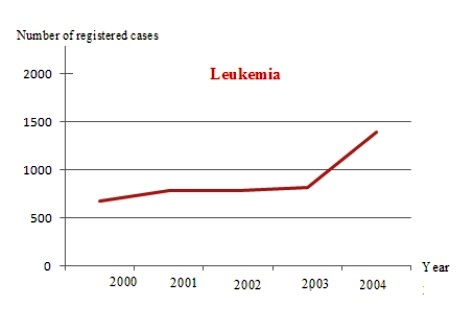
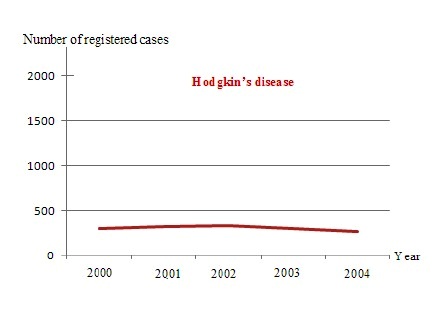
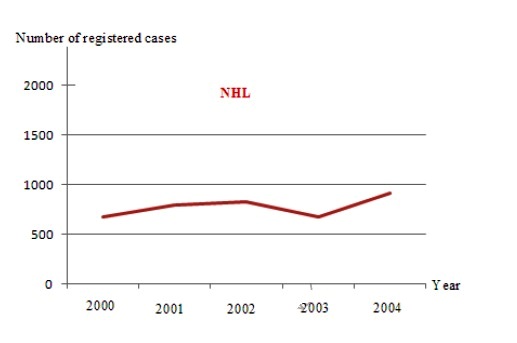
The top skin cancers in Iraq (2000-2004) were basal cell carcinoma, squamous cell carcinoma, melanoma, dermatofibrosarcoma, basosquamous carcinoma, Kaposi sarcoma. Basal cell carcinoma was the commonest skin cancer in Iraq. There were 1111 cases of basal cell carcinoma accounting for (43%) of all skin cancers. squamous cell carcinoma was the second most common skin cancer in Iraq. There were 904 cases of squamous cell carcinoma accounting for (35%) of all skin cancers. Melanoma was the third most common skin cancer in Iraq. There were 160 cases of melanoma accounting for only (6%) of all skin cancers. Table-2E shows the percentage of various histopathologies of skin cancers. Three cancers including basal cell carcinoma, squamous cell carcinoma, and melanoma accounted for more than 80% of all histopathological types [5, 6].
| Histopathology | Number (%) |
| BCC | 1111(43%) |
| SCC | 904 (35%) |
| Melanoma | 160 (6%) |
| Dermatofibrosarcoma | 52 (2%) |
| Basosquamous carcinoma | 48 (1.85%) |
| Kaposi sarcoma | 48 (1.85%) |
| SCS Ker type | 29 (1.1%) |
| Epithelial tumor | 24 (0.9%) |
| Adenocarcinoma | 17 (0.66%) |
| Fibrous Histocytoma | 12 (046%) |
| Liposarcoma [4 Myxoid] | 8 |
| Sebaceous Adenocarcinoma | 6 |
| Bownes’s disease | 3 |
| Ecc Acrospiroma | 2 |
Table-2E: The percentage of various histopathologies of skin cancers (2000-2004)
The incidence of skin cancers including melanoma and non-melanoma skin cancers has been reported to be rapidly increasing in some parts of the world. The rising incidence of non-melanoma skin cancers was attributed to a combination of increased sun exposure or exposure to ultraviolet (UV) light, increased outdoor activities, changes in clothing style, increased longevity, ozone depletion, genetics and in some cases, immune suppression. The frequency of the occurrence of non-melanoma skin cancers was closely associated with the constitutive color of the skin and depends on the geographical zone. The highest incidence rates were reported from Queensland, Australia with 56 new cases per year per 100,000 for men and 43 for women. The Robert Koch Institute in Germany estimated the incidence of melanoma skin cancer as 7 cases in 100 000 persons during the period from 1998 and 2001, Katalinic A et al reported the registration of 1784 malignant melanoma with an estimated incidence rates of 12.3 and 14.8 in 100 000 men and women. However, the incidence of non-melanoma skin cancers in Iraq (2000-2004) was lower despite being a region with high ultraviolet light exposure [5, 6].
CHILDHOO MALIGNANCIES IN IRAQ (2000-2004)
Childhood malignancies (age at diagnosis: 0-14 years) include a variety of malignancies, with incidence varying worldwide by age, sex, ethnicity and geography. Considerable geographic regional differences in the incidence of childhood cancer have been increasingly reported. The incidence of childhood malignancies varies according to gender, age, race, and ethnicity. During five-year period (2000-2004), 63923 Iraqi patients with various types of newly diagnosed malignancies were reported by the Iraqi Ministry of Health from all Iraqi provinces with the exception of 3 Northern provinces (Sulaimanyia, Erbil, and Dohouk).
5049 cases of malignancies were observed in children under 14 years of age accounting for approximately 8% of all cancer cases in Iraq. Leukemia was by far the commonest childhood malignancy in Iraq accounting for 33% of childhood malignancies. The top 10 childhood malignancies were: leukemias, Hodgkin lymphomas (NHL), central nervous system neoplasms, non-Hodgkin lymphomas (NHL), renal tumors, bone tumors and Eye (retinoblastomas), soft tissues tumors, adrenal gland tumors, and tumors of testis and ovary. Liver malignancies ranked 11th in the list accounting for less than 1% of malignancies.
The top 10 childhood malignancies in males as shown in table-3 were: leukemias, Hodgkin lymphomas (NHL), central nervous system neoplasms, non-Hodgkin lymphomas (NHL), renal tumors, bone tumors and Eye (retinoblastomas), soft tissues tumors, adrenal gland tumors, and tumors of ovary. The top 10 childhood malignancies in females as shown in table-3 were: Leukemias, central nervous system neoplasms Hodgkin lymphomas (NHL), central nervous system neoplasms, non-Hodgkin lymphomas (NHL), renal tumors, bone tumors and Eye (retinoblastomas), soft tissues, tumors, adrenal gland tumors, and tumors of testis and ovary [5, 7, 8].
| No (%) | Males | Females |
| Leukemia | 1675 (33%) | 999 | 676 |
NHL | 834(16.5%) | 537 | 297 |
| Brain &CNS | 786(15.6%) | 459 | 327 |
| Hodgkin lymphoma | 262 (5%) | 193 | 69 |
| Kidney | 246 (4.9%) | 135 | 111 |
| Bone | 227(4.5%) | 127 | 100 |
| Eye | 173(3.4%) | 102 | 71 |
| Soft tissues | 159 (3.1%) | 91 | 68 |
| Adrenal | 106 (2.1%) | 55 | 51 |
| Testis/Ovary | 90 (1.8%) | 26 | 64 |
| Liver | 45 (0.9%) | 23 | 22 |
Table-3: The numbers and percentages of the commoner childhood malignancies
The frequency of childhood malignant disease in children has been reported to vary among countries. For example, in children in Canada, the United States, and Europe, the three most common cancers are leukemias, tumors of the central nervous system (CNST), and lymphomas, whereas in children in Latin America, the order of frequencies is distinct: leukemias are still in first place, with lymphomas being more common than are CNS malignancies. In other countries such as Nigeria, Malawi, and Egypt, lymphomas are the main malignancies. The percentage of cases of each type of childhood malignancies in relation to the total number of malignancies was also different. In the developed countries, leukemias account for 30 to 37%, CNS malignancies account for 18 to 27%, and lymphomas, account for 7 to 12%.
In Latin America, leukemias account for 27 to 44%; of lymphomas, between 13 and 22%; and of CNST, between 10 and 19%. In African countries, lymphomas account for 30 and 64%.
In Asian countries such as Japan and China, leukemias account for 30 to 40%, CNS malignancies account for 12 to 20%, lymphomas account for 10 to 20%. During the decade 1968-1977, a total of 1488 cases of childhood malignancies were reported from Slovakia in children aged 0-14 years. The most common malignancies were leukemias (28.2%), nervous system malignancies (23.9%), lymphomas (14.9%), and Wilm's tumors of kidney (6.7%). In Poland, the most frequent childhood malignancies include leukemia,
which accounts for (28%), lymphoma (14.3%) and CNS malignancies (16.3%).
Hematopoietic system malignancies (leukemias and lymphomas) account for about 42% of all childhood malignancies. Malignant lymphomas, bone tumors and germinal tumors were more frequently diagnosed in Poland, but the incidence of central nervous system tumors was lower than in other countries. Figure-3 shows the pattern of childhood malignancies in four countries. During the years 2000 to 2004, the pattern of childhood malignancies in Iraq was slightly different from the patterns in other countries. Higher frequency of leukemias than most other countries [5, 7, 8].
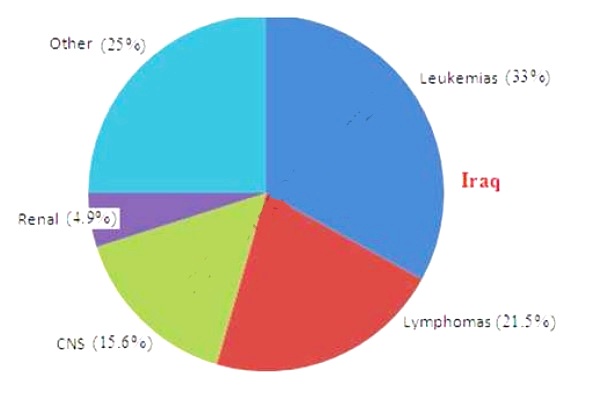
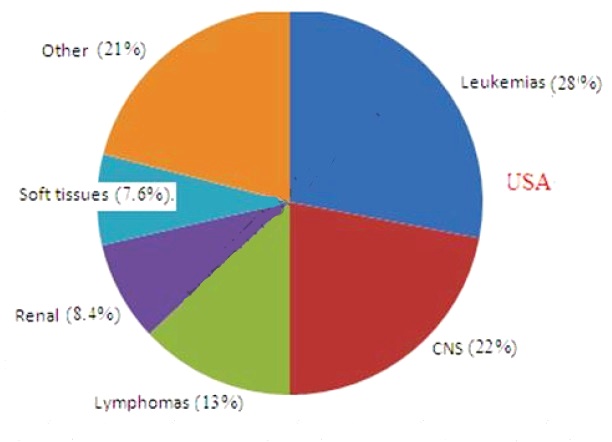

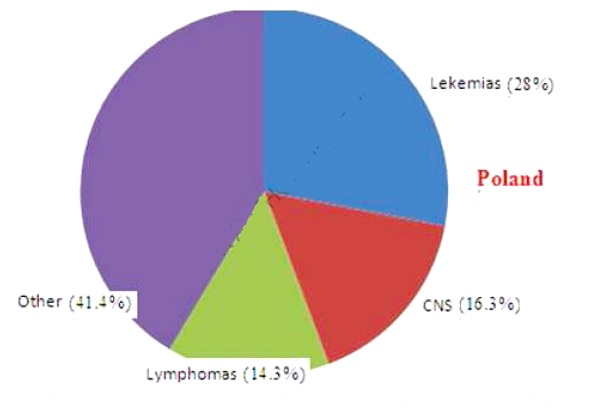
THE PATTERN OF MALIGNANCY IN IRAQ (2006)
During the year 2006, 15226 patients (7377 males and 7849 females) with malignant diseases were recorded by the Iraqi Ministry of Health. As the Iraqi Ministry of planning estimated the population of Iraq to be 28 million and 810441, malignant disease occurred in 52.85 of each 100000 population during the year 2006. The three most common cancers were breast cancer which accounted for 17.35 percent and occurred in 9.17 of each 100000 population, cancer of the lung and bronchus which accounted for 8.35 percent and occurred in 4.42 of each 100000 population, and leukemias which accounted for 7.72 percent and occurred in four of each 100000 population, Table-4A shows the numbers and percentages of the commoner ten malignancies by primary site during the year 2006.
The three most common cancers in males during the year 2006 were cancer of the lung and bronchus which accounted for 13.5% of male malignancies and occurred in 6.69 of each 100000 male population, urinary bladder cancer which accounted for 10.25% of male malignancies and occurred in 5.22 of each 100000 male population, and leukemias which accounted for 9 % of male malignancies and occurred in 4.59 of each 100000 male population, Table-4B shows the numbers and percentages of the commoner ten malignancies by primary site in males during the year 2006 [9,10].
| Malignant disease | Number (%) | Male | Female |
| Breast | 2642 (17.35%) | 104 | 2538 |
| Lung and bronchus | 1272 (8.35%) | 970 | 302 |
| Leukemias | 1176 (7.72%) | 665 | 511 |
| Urinary bladder | 979 (6.43%) | 756 | 223 |
| Non-Hodgkin lymphoma | 893 (5.86%) | 530 | 363 |
| Brain and CNS | 793 (5.21%) | 431 | 362 |
| Colorectal | 717 (4.71%) | 387 | 330 |
| Skin including melanoma | 511 (3.35%) | 278 | 233 |
| Stomach | 490 (3.22%) | 282 | 208 |
| Larynx | 466 (3.06%) | 340 | 126 |
Table-4A: The numbers and percentages of the commoner ten malignancies by primary site during the year 2006
| Malignant disease | Number (%) |
| Lung and bronchus | 970 (13.5% %) |
| Urinary bladder | 756 (10.23%) |
| Leukemias | 665 (9%) |
| Non-Hodgkin lymphoma | 530 (7.18%) |
| Brain and CNS | 431 (5.84%) |
| Colorectal | 378 (5.1%) |
| Larynx | 340 (4.61%) |
| Prostate | 300 (4.07%) |
| Stomach | 282(3.82%) |
| Skin including melanoma | 278 (3.77%) |
Table-4B: The numbers and percentages of the commoner ten malignancies by primary site in males during the year 2006
The three most common cancers in females were breast cancer which accounted for 32.34 % and occurred in 17.73 of each 100000 female population, leukemias which accounted for 6.51 % and occurred in 3.57 of each 100000 female population, and non-Hodgkin lymphoma which accounted for 4.62 % and occurred in 2.54 of each 100000 female population, Table-4C shows the numbers and percentages of the commoner ten malignancies by primary site in females during the year 2006.
The three most common childhood malignancies were leukemias which accounted for 36.68%, non-Hodgkin lymphoma which accounted for 14.27%, and brain malignancies which accounted for11.65 %. Table-4D shows the numbers and percentages of the commoner ten childhood malignancies by primary site during the year 2006[9.10].
| Malignant disease | Number (%) |
| Breast | 2538 (32.34%) |
| Leukemias | 511 (6.51%) |
| Non-Hodgkin lymphoma | 363(4.62 %) |
| Brain and CNS | (4.61%) |
| Colorectal | 330 (4.2%) |
| Lung and bronchus | 302(3.85%) |
| Ovary | 288 (3.67%) |
| Urinary bladder | 233 (2.84%) |
| Skin including melanoma | 233 (2.96%) |
| Stomach | 208(2.65%) |
Table-4C: The numbers and percentages of the commoner ten malignancies by primary site in females during the year 2006
| Malignant disease | Number (%) | Male | Female |
| Leukemias | 406 (36.68%) | 234 | 172 |
| Non-Hodgkin lymphoma | 158 (14.27%) | 99 | 59 |
| Brain | 129 (11.65%) | 82 | 47 |
| Bone | 59 (5.33%) | 27 | 32 |
| Eye | 51 (4.61%) | 31 | 20 |
| Kidney | 50 (4.52%) | 20 | 30 |
| Hodgkin disease | 47 (4.25%) | 34 | 13 |
| Soft tissues | 27 (2.44%) | 15 | 12 |
| Adrenal glands | 23 (2.08%) | 12 | 11 |
| Liver | 17 (1.54%) | 12 | 5 |
Table-4D: The numbers and percentages of the commoner ten childhood malignancies by primary site during the year 2006
The commoner childhood malignancies were commoner in males except kidney malignancies which were more common in females. During the year 2006, 2642 (2538 in females and 104in males) cases of breast malignancies were reported by the Iraqi Ministry of Health. Histopathological examination was available for 1901 cases (71.95%). Infiltrating duct carcinoma was the most common histopathological and occurred was found in 1646 cases (62.38%). Adenocarcinoma, NOS was the second most common histopathological and was found in 75 cases (2.84%). Lobular carcinoma, NOS was the third most common histopathological and was found in 58 cases (2.2%). Table-4E shows the frequency of various histopathological types of breast malignancies in Iraq (2006) [9, 10].
Histopathological type | Number (%) |
| Infiltrating duct carcinoma | 1646 (62.38%) |
| Adenocarcinoma, NOS | 75 (2.84%) |
| Lobular carcinoma, NOS | 58 (2.2%) |
| Epithelial tumor | 53(2%) |
| Intra-ductal papillary adenocarcinoma | 12 (0.45%) |
| Medullary carcinoma, NOS | 11 (0.42%) |
| Squamous cell carcinoma, NOS | 7(0.26%) |
| Mucinous adenocarcinoma | 6 (0.23%) |
| Comedo carcinoma, NOS | 6 (0.23%) |
| Phyllodes tumor | 6 (0.23%) |
| Infiltrating duct and lobular carcinoma | 4 (0.15%) |
| Paget's disease | 4 (0.15%) |
| Undifferentiated carcinoma, NOS | 3 (0.11%) |
| Giant cell type | 1 (0.04%) |
| Pleomorphic carcinoma | 1 (0.04%) |
| Superficial spreading adenocarcinoma | 1 (0.04%) |
| Tubular adenocarcinoma | 1 (0.04%) |
| Juvenile carcinoma | 1 (0.04%) |
| Paget's disease and Infiltrating duct carcinoma | 1 (0.04%) |
| Lioposarcoma, NOS | 1 (0.04%) |
| Hemangioendothelioma | 1 (0.04%) |
Table-4E: The frequency of various histopathological types of breast malignancies in Iraq (2006)
During the year 2006, 1272 (970 in males and 302) cases of malignancies of the lung and bronchus were reported by the Iraqi Ministry of Health. Histopathological examination was available for 567 cases (44.58%). Squamous cell carcinoma, NOS was the most common histopathological and was found in 253 cases (19.89%). Adenocarcinoma, NOS was the second most common histopathological and was found in 90 cases (7.08%). Small cell carcinoma, NOS was the third most common histopathological and was found in 51 cases (4 %). Table-4F shows the frequency of various histopathological types of malignancies of the lung and bronchus in Iraq (2006) [9, 10].
Histopathological type | Number (%) |
| Squamous cell carcinoma, NOS | 253 (19.89%) |
| Adenocarcinoma, NOS | 90 (7.08%) |
| Small cell carcinoma, NOS | 51 (4 %) |
| Epithelial tumor | 48 (3.77%) |
| Bronchiolo-alveolar adenocarcinoma | 46 (3.62%) |
| Large cell carcinoma, NOS | 34 (2.67%) |
| Undifferentiated carcinoma, NOS | 15 (1.18%) |
| Oat cell carcinoma | 10 (0.79%) |
| Squamous-small cell carcinoma, non keratinized | 3 (0.24 %) |
| Giant cell type | 2 (0.16%) |
| Small-intermediate cell carcinoma | 2 (0.16%) |
| Rhabdomyosarcoma, NOS | 2 (0.16%) |
| Small-large cell carcinoma | 1 (0.08%) |
| Papillary carcinoma, NOS | 1 (0.08%) |
| Scirrous adenocarcinoma | 1 (0.08%) |
| Adenoid cystic carcinoma, NOS | 1 (0.08%) |
| Carcinoid tumor, NOS, except appendix | 1 (0.08%) |
| Leiomyosarcoma, NOS | 1 (0.08%) |
| Pulmonary blastoma | 1 (0.08%) |
| Carcino-carcinoma, NOS | 1 (0.08%) |
| Mesothelioma | 1 (0.08%) |
Table-4F: The frequency of various histopathological types of malignancies of the lung and bronchus in Iraq (2006)
THE PATTERN OF MALIGNANCY IN IRAQ (2009)
During the year 2009, patients 15251 (7201 males and 8050 females) with malignant diseases were recorded by the Iraqi Ministry of Health. As the Iraqi Ministry of planning estimated the population of Iraq to be 31 million and 664466, malignant disease occurred in 48.16 of each 100000 population during the year 2009. The three most common cancers were breast cancer which accounted for 19.59% and occurred in 9.43 of each 100000 population, cancer of the lung and bronchus which accounted for10.29 % and occurred in 4.96 of each 100000 population, and brain and CNS cancer which accounted for 6.31 % and occurred in 3.04 of each 100000 population, Table-5A shows the numbers and percentages of the commoner ten malignancies by primary site during the year 2009. The three most common cancers in males during the year 2009 were lung and bronchus malignancies which accounted for15.98% of male malignancies and occurred in 7.23 of each 100000 male population, urinary bladder malignancies which accounted for 10.32 % of male malignancies and occurred in 4.67 of each 100000 male population, and Brain and CNS which accounted for 7.37 % of male malignancies, and occurred in 3.34 of each 100000 male population [11, 12].
| Malignant disease | Number (%) | Male | Female |
| Breast | 2987(19.59%) | 81 | 2906 |
| Lung and bronchus | 1570 (10.29%) | 1151 | 419 |
| Brain and CNS | 962 (6.31%) | 531 | 431 |
| Urinary bladder | 957 (6.27%) | 743 | 214 |
| Leukemias | 908 (5.95%) | 506 | 402 |
| Non-Hodgkin lymphoma | 737 (4.83 %) | 458 | 279 |
| Colorectal | 701 (4.6%) | 387 | 314 |
| Skin | 609 (3.99%) | 352 | 257 |
| Stomach | 538 (3.53%) | 307 | 231 |
| Larynx | 377(2.47%) | 279 | 98 |
Table-5A: The numbers and percentages of the commoner ten malignancies by primary site during the year 2009
Table-5B shows the numbers and percentages of the commoner ten malignancies by primary site in males during the year 2009.
| Malignant disease | Number (%) |
| Lung and bronchus | 1151 (15.98%) |
| Urinary bladder | 743(10.32%) |
| Brain and CNS | 531 (7.37%) |
| Non-Hodgkin lymphoma | 530 (7.18%) |
| Brain and CNS | 431 (5.84%) |
| Colorectal | 378 (5.25 %) |
| Larynx | 340 (4.61%) |
| Prostate | 300 (4.07%) |
| Stomach | 282(3.82%) |
| Skin including melanoma | 278 (3.77%) |
Table-5B: The numbers and percentages of the commoner ten malignancies by primary site in males during the year 2009
The three most common cancers in females were breast malignancies which accounted for 36.1% and occurred in 18.45 of each 100000 female population, Brain and CNS malignancies which accounted for 5.35% and occurred in 2.74 of each 100000 female population, and lung and bronchus which accounted for 5.2% and occurred in 2.66 of each 100000 female population, Table-5C shows the numbers and percentages of the commoner ten malignancies by primary site in females during the year 2009 [11, 12].
| Malignant disease | Number (%) |
| Breast | 2906 (36.1%) |
| Brain and CNS | 431 (5.35%) |
| Lung and bronchus | 419 (5.2%) |
| Leukemias | 402 (4.99%) |
| Colorectal | 314 (3.9%) |
| Ovary | 307 (3.81%) |
Table-5C: The numbers and percentages of the commoner ten malignancies by primary site in females during the year 2009
The three most common childhood malignancies were leukemias which accounted for 30.44%, brain malignancies which accounted for 17.73% and non-Hodgkin lymphoma which accounted for 11.43%. Table-5D shows the numbers and percentages of the commoner childhood malignancies by primary site during the year 2009.
| Malignant disease | Number (%) | Male | Female |
| Leukemias | 309 (30.44%) | 167 | 142 |
| Brain | 180 (17.73%) | 111 | 69 |
| Non-Hodgkin lymphoma | 116(11.43%) | 79 | 37 |
| Kidney | 77 (7.59%) | 42 | 35 |
| Bone | 62 (6.11%) | 34 | 28 |
| Hodgkin disease | 58 (5.71%) | 36 | 22 |
| Eye | 40 (3.39%) | 24 | 16 |
| Soft tissues | 29 (2.86%) | 14 | 15 |
Table-5D: The numbers and percentages of the commoner childhood malignancies by primary site during the year 2009
The commoner childhood malignancies were commoner in males except soft tissues malignancies which were slightly more common in females.
During the year 2009, 2987 (2906 in females and 81 in males) cases of breast malignancies were reported by the Iraqi Ministry of Health. Histopathological examination was available for 2350 cases (78.67%). Infiltrating duct carcinoma was the most common histopathological and was found in 1917 cases (64.18%). Intra-ductal papillary adenocarcinoma was the second most common histopathological and was found in cases 106 (3.55%). Adenocarcinoma, NOS was the third most common histopathological and was found in 77 (2.58%) cases [11,12]. Table-5E shows the frequency of various histopathological types of breast malignancies in Iraq (2009).
Histopathological type | Number (%) |
| Infiltrating duct carcinoma | 1917 (64.18%) |
| Intra-ductal papillary adenocarcinoma | 106 (3.55%) |
| Adenocarcinoma, NOS | 77 (2.58%) |
| Carcinoma, NOS | 77 (2.58%) |
| Lobular carcinoma, NOS | 61 (2.04%) |
| Infiltrating duct and lobular carcinoma | 22 (0.74%) |
| Infiltrating ductular carcinoma | 17(0.57%) |
| Medullary carcinoma | 17(0.57%) |
| Squamous cell carcinoma | 10 (0.33%) |
| Mucinous adenocarcinoma | 8 (0.27%) |
| Phyllodes tumor | 7 (0.23%) |
| Comedo carcinoma | 5 (0.17%) |
| Paget's disease | 4 (0.13%) |
| Papillary carcinoma | 4 (0.13%) |
| Cribriform carcinoma | 3 (0.1%) |
| Adenoid cystic carcinoma | 2 (0.07%) |
| Pleomorphic carcinoma | 2 (0.07%) |
| Scirrhous carcinoma | 2 (0.07%) |
| Adeno-squamous carcinoma | 1 (0.03%) |
| Fibrosarcoma | 1 (0.03%) |
| Malignant fibrous histocytoma | 1 (0.03%) |
| Myxoid liposarcoma | 1 (0.03%) |
| Neuro-endocrine carcinoma | 1 (0.03%) |
| Paget's disease-infiltrating duct carcinoma | 1 (0.03%) |
| Pleomorphic liposarcoma | 1 (0.03%) |
| Spindle cell carcinoma | 1 (0.03%) |
| Tubular adenocarcinoma | 1 (0.03%) |
Table-5E: The frequency of various histopathological types of breast malignancies in Iraq (2009)
During the year 2009, 1570 (1151 in males and 419 in females) cases of malignancies of the lung and bronchus were reported by the Iraqi Ministry of Health. Histopathological examination was available for cases 910 (57.96%). Squamous cell carcinoma, NOS was the most common histopathological and was found in 437 cases (27.83%). Adenocarcinoma, NOS was the second most common histopathological and was found in 181 cases (11.53%). Carcinoma, NOS was the third most common histopathological and was found in 95 cases (6.05%) [11, 12]. Table-4F shows the frequency of various histopathological types of malignancies of the lung and bronchus in Iraq (2006). Table 5F shows the frequency of various histopathological types of malignancies of the lung and bronchus in Iraq (2009).
Histopathological type | Number (%) |
| Squamous cell carcinoma, NOS | 437 (27.83%) |
| Adenocarcinoma, NOS | 181 (11.53%) |
| Carcinoma, NOS | 95 (6.05%) |
| Small cell carcinoma, NOS | 81 (5.16%) |
| Bronchiolo-alveolar adenocarcinoma | 49 (3.12%) |
| Large cell carcinoma | 23 (1.46%) |
| Oat cell carcinoma | 17 (1.08%) |
| Small-large cell carcinoma | 8 (0.51%) |
| Adeno-squamous carcinoma | 4 (0.25%) |
| Carcinoid tumor | 3 (0.19%) |
| Soft tissue tumor | 3 (0.19%) |
| Adenoid squamous cell carcinoma | 2(0.13%) |
| Clear cell adenocarcinoma | 2(0.13%) |
| Acinar cell adenocarcinoma | 1 (0.06%) |
| Cystadenocarcinoma | 1 (0.06%) |
| Fibrosarcoma | 1 (0.06%) |
| Pseudosarcomatous carcinoma | 1 (0.06%) |
| Spindle cell carcinoma | 1 (0.06%) |
Table-5F: The frequency of various histopathological types of malignancies of the lung and bronchus in Iraq (2009)
THE PATTERN OF CANCER IN IRAQ (2015-2018)
During four-year period (2015-2018), 111350 new cases of cancer (43.6% males and 56.4%) females) were recorded by the Iraqi Ministry of health including 25,269 cases during the year 2015, 25556 cases during the year 2016, 29023 cases during the year 2017, and 31502 cases during the year 2018. During these four years, above 70-year population was the most affected age group, and the incidence of cancer was generally increasing with age. During this four-year period, breast cancer was the number one cancer in Iraq accounting for 19.1% of the total registered cases of cancer during the year 2015, 19.55% of the total registered cases of cancer during the year 2016, 20.50% of the total registered cases of cancer during the year 2017, and 19.70% of the total registered cases of cancer during the year 2018. Bronchial and pulmonary cancer was the second most common cancer during this four-year period accounting for 8.1% of the total registered cases of cancer during the year 2015, 8.31%, of the total registered cases of cancer during the year 2016, 7.80% of the total registered cases of cancer during the year 2017, and 8.19% of the total registered cases of cancer during the year 2018. Cancer of the bronchus and lung cancer was the most common cancer in males occurring in (6.7/100,000 males in 2015, 7.76/100,000 males in 2016, 8.42\100,000 males in 2017, and 9.50/100,000 males in 2018 [13]. Table-6A shows the numbers of percentages of cancers by primary site in Iraq during four-year period (2015-2018).
Breast | 21977 (19.74%) |
Bronchus & lung | 8994 (8%) |
Leukemia | 7349 (6.6%) |
Colorectal | 6611 (5.94%) |
Urinary bladder | 5696 (5.11%) |
Brain & other CNS tumors | 5681 (5.1%) |
Non-Hodgkin lymphomas | 5025 (4.5%) |
Thyroid gland | 4567 (4.1%) |
Skin | 3869 (3.47%) |
Other site cancers | 41581 (37.34%) |
Total cancer | 111350 |
Table-6A: The numbers and percentages of cancers by primary site in Iraq during four-year period (2015-2018)
Table-6B shows the numbers of percentages of cancers in males by primary site in Iraq during four-year period (2015- 2018). Table-6C shows the numbers of percentages of cancers in females by primary site in Iraq during four-year period (2015-2018).
Bronchus & lung | 6322 (13%) |
Urinary bladder | 4296 (8.85 %) |
Leukemia | 4108 (8.47%) |
Colorectal | 3496 (7.2%) |
Prostate | 3399 (7%) |
Brain & other CNS tumors | 2991 (6.16%) |
Non-Hodgkin lymphomas | 2701 (5.56%) |
Skin | 2043 (4.2%) |
Stomach | 1869 (3.85%) |
Other site cancers | 17286 (35.63%) |
Total in males | 48511 |
Table-6B: The numbers of percentages of cancers in males by primary site in Iraq during four-year period (2015-2018)
During this four-year period (2015-2018), 6442 new cases of cancer were registered in children from birth to 14 year of age accounting for about 5.78% of the total registered cases, and including 1556 in 2015, 1511 in 2016, 1660 during the year 2017, and 1715 during the year 2018. Leukemia was the number one cancer in children occurring in 3/100,000 children during the year 2015, 3.07./100,000 during the year 2016, 3.71\100,000 during the year 2017, and 3.56/100,000 during the year 2018. During this four-year period (2015-2018), a total of patients died from cancer including 8825 patients during the year 2015, 7568 patients during the year 2016, 7145 patients during the year 2017, and 10,293 patients during the year 2018.
Breast | 21587 (34.35%) |
Thyroid gland | 3450 (5.5%) |
Leukemia | 3241 (5.1%) |
Colorectal | 3120 (4.96%) |
Brain & other CNS tumors | 2688 (4.27%) |
Bronchus & lung | 2672 (4.25%) |
Ovary | 2557 (4%) |
Non-Hodgkin lymphomas | 2324 (3.7%) |
Skin | 1826 (2.9%) |
Other site cancers | 19354 (30.8%) |
Total cancer | 62839 |
Table-6C: The numbers of percentages of cancers in females by primary site in Iraq during four-year period (2015-2018)
The World Health Organization considered that lung, prostate, colorectal, stomach and liver cancers as the most common types of cancer in males in the world, while breast, colorectal, lung, cervical and thyroid cancers were considered the most common in females in the world.
However, the most common types of cancer by primary site in Iraqi males were lung, bladder, leukemia, colorectal, and prostate cancers. Therefore, the pattern of male cancers in Iraq was not very similar to the latest global pattern reported by the World Health Organization in 2018. In addition, as the most common types of cancer by primary site in Iraqi females were breast, thyroid, leukemia, colorectal, and brain & other CNS tumors. The pattern of female cancers in Iraq was also not very similar to the latest global pattern reported by the World Health Organization in 2018. In the largest previously published series of 63923 Iraqi patients with various types of newly diagnosed cancer registered during five-year period (2000-2004), cancers of the breast, lung & bronchus, leukemia, Bladder, and brain & CNS were the most common cancers. However, in this study cancers of the breast, lung & bronchus, leukemia, Colorectal, and bladder were the most common, suggesting some change in pattern of cancer with more colorectal cancer and less brain & CNS.
The findings in this study suggested that the incidence rate of new cases was increasing during the previous decades as it was 38.91/100,000 population in 1994, 52.8\100,000 in 2006, and 82.62/100,000 population in 2018. The pattern of cancers in Iraq was not very similar to the latest global pattern reported by the World Health Organization [13].
THE PATTERN OF CHILDHOOD CANCER IN IRAQ (2015-2018)
During four-year period (2015-2018), 6442 new cases of cancer were registered in children from birth to 14 year of age accounting for about 5.8% of the total registered cases, and including 1556 in 2015, 1511 in 2016, 1660 during the year 2017, and 1715 during the year 2018.
Leukemia was the number one cancer in children occurring in 3/100,000 children during the year 2015, 3.07./100,000 during the year 2016, 3.71\100,000 during the year 2017, and 3.56/100,000 during the year 2018. Table-7A shows the numbers of the commoner types of childhood cancer.
Number | Male | Female | |
Leukemia | 2028 | 1148 (56.6%) | 880 (43.4%) |
Brain and CNS cancer | 1123 | 613 (54.6%) | 510 (45.4%) |
Non-Hodgkin lymphoma | 607 | 418 (69%) | 189 (31%) |
Hodgkin lymphoma | 499 | 312 (62.5%) | 187 (37.5%) |
Bone cancer | 401 | 225 (56%) | 176 (44%) |
Renal cancer | 387 | 189 (48.8%) | 198 (51.2%) |
Soft tissue cancer | 199 | 117 (58.8%) | 82 (41.2%) |
Eye cancer | 196 | 87 (44.4%) | 109 (55.6%) |
Other | 1002 | 528 (52.7%) | 474 (47.3%) |
Total | 6442 | 3637 (56.5%) | 2805 (43.5%) |
Table-7A: The numbers of the commoner types of childhood cancer
Brain and CNS cancer was the second most common childhood cancer. Non-Hodgkin lymphoma was the third most common childhood cancer in males while renal cancer was the third most common childhood cancer in females. Most common childhood cancers were commoner in males, but renal cancer and eye cancer were commoner in females. Figure-7A shows the order of the commoner childhood cancers in males and figure-7B shows the order of the commoner childhood cancers in females [14].
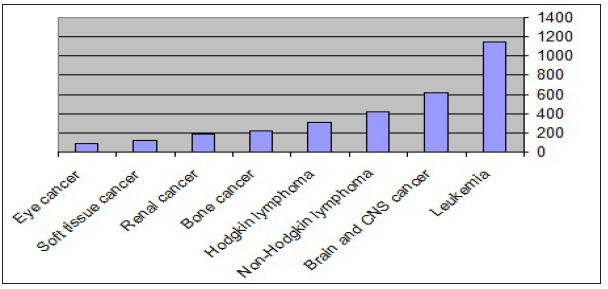
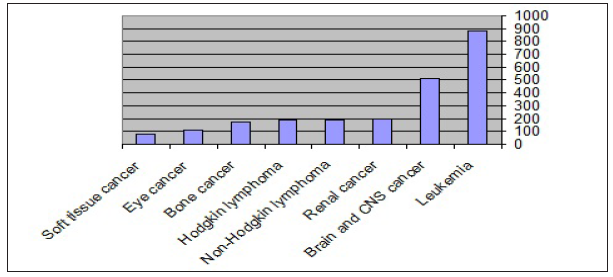
In the previously published largest series of 63923 Iraqi patients with various types of newly diagnosed cancer registered by the Iraqi Ministry of Health during five-year period (2000-2004), 5049 cases of cancers occurred in children under 14 years of age accounting for approximately 8% of all cancer cases in Iraq, while in this study childhood cancers accounted for about 5.8% of the total registered cases of cancer. In the previous study, leukemia was most common childhood cancer like in this study. However, Non-Hodgkin lymphoma was the second most common childhood cancer in males while brain and CNS cancer was the second most common childhood cancer in females. Brain and CNS cancer was the third most common childhood cancer in males, while non-Hodgkin lymphoma was the third most common childhood cancer in females [14]. Table- 7B shows the numbers of the commoner types of childhood cancer during five-year period (2000-2004).
Number | Male | Female | |
| Leukemia | 1675 (33%) | 999 | 676 |
| NHL | 834(16.5%) | 537 | 297 |
| Brain &CNS | 786(15.6%) | 459 | 327 |
| Hodgkin lymphoma | 262 (5%) | 193 | 69 |
| Kidney | 246(4.9%) | 135 | 111 |
| Bone | 227(4.5%) | 127 | 100 |
| Eye | 173(3.4%) | 102 | 71 |
| Soft tissues | 159 (3.1%) | 91 | 68 |
| Adrenal | 106 (2.1%) | 55 | 51 |
| Testis/Ovary | 90 (1.8%) | 26 | 64 |
| Liver | 45 (0.9%) | 23 | 22 |
Table-7B: The numbers of the commoner types of childhood cancer during five-year period (2000-2004)
Cancers in children has been reported to have different patterns in various countries of the world. In Costa Rica, during the 15-year period, 2396 cases of cancers in children were reported Most frequent cancer types were leukemia (40.5%), brain and CNS) tumors (13.9%), and lymphomas (12.7%). Stefan (2015) emphasized that information about childhood cancers is not available from many geographic regions in the world especially from Africa. However, Stefan estimated that the most common childhood cancers in Africa were nephroblastoma, leukemia, retinoblastoma, and Burkitt lymphoma. The pattern of childhood cancers in Iraq witnessed some changes during the previous decades.
Acknowledgment
Some of the figures and tables in this paper were included I previous author's publications, but he has their copyrights.
Conflict of interest
None.
References
- Al-Mosawi AJ. (2021) Il modello dei tumori maligni in Iraq: gli archivi nazionali (Italian edition). Edizioni Sapienza: (ISBN-13:978-620-3-67181-0, ISBN-10: 6203671819).
- Al-Mosawi AJ. (2021) The Evolution of Cancer in Iraq: A Half-Century Overview (French edition). Editions Notre Savoir: (ISBN-13: 978-620-3-67197-1, ISBN-10: 6203671 975).
- Al-Mosawi AJ. The (2021) pattern of cancers in Iraq: Half-Century Overview (English Edition). Editions Our Knowledge: (ISBN-10: 6203672068, ISBN-13: 978-6203672060).
- Al-Mosawi AJ. Cancer incidence (2021) in Iraq: A Half-Century Review (Polish Edition). Wydawnictwo Nasza Wiedza: (ISBN-10: 6203672033, ISBN-13: 978-6203672039).
- Al-Mosawi AJ. (2011) The pattern of cancer in Iraq. 1st ed., Saarbrücken; LAP Lambert Academic Publishing: (ISBN: 978-3-8473-3750-8). Doi:10.13140/rg.2.1.2349.0324
- Al-Mosawi AJ. (2020) Malignant Diseases in Iraq: An Overview of the Available National Published Data. Archives of Oncology and Cancer Therapy (ISSN: 2638-5074) Dec; 3 (2): 01-03.
- Al-Mosawi AJ. (2009) Childhood Cancers in Iraq. Section on international child health: American Academy of Pediatrics Newsletter. Fall: 18-19. Doi: 10.5281/ zenodo.3878860
- Al-Mosawi AJ. (2020) Malignant Diseases in Iraq: An Overview of the Available National Published Data. Archives of Oncology and Cancer Therapy (ISSN: 2638-5074) Dec; 3 (2): 01-03.
- Al-Mosawi AJ. (2021) Het patroon van kanker in Irak: Overzicht van een halve eeuw (Dutch Edition). Uitgeverij Onze Kennis: (ISBN-6203672017. ISBN-13 : 978-620367201 5).
- Al-Mosawi AJ. (2021) Das Muster von Krebserkrankungen im Irak:Überblick über ein halbes Jahrhundert (German Edition).Verlag Unser Wissen: (ISBN-10: 620367195 9, ISBN-13 : 978-6203671957).
- Al-Mosawi AJ. (2021) Structure of Cancer in Iraq: A Half-Century Overview. Sciencia Scripts : (ISBN-13:978-620-3-67207-7, ISBN-10:6203672076).
- Al-Mosawi AJ. (2021) El patrón de los cánceres en Irak: Panorama de medio siglo. Ediciones Nuestro Conocimiento : (ISBN-13:978-620-3-67196-4,ISBN-10:620367 1967).
- Al-Mosawi AJ. (2020) The Pattern of Cancer in Iraq (2015-2018): An Overview. Archives of Oncology and Cancer Therapy (ISSN: 2638-5074) Dec 8; 3 (2): 11-13.
- Al-Mosawi AJ. (2020) The Pattern of Childhood Cancer in Iraq (2015-2018). Archives of Oncology and Cancer Therapy (ISSN: 2638-5074) Dec; 3 (2): 14-16.
Quick linksss
- Abstract
- THE PATTERN OF MALIGNANCY IN IRAQ (1976-1985)
- THE PATTERN OF MALIGNANCY IN IRAQ (2000-2004)
- CHILDHOO MALIGNANCIES IN IRAQ (2000-2004)
- THE PATTERN OF MALIGNANCY IN IRAQ (2006)
- THE PATTERN OF MALIGNANCY IN IRAQ (2009)
- THE PATTERN OF CANCER IN IRAQ (2015-2018)
- THE PATTERN OF CHILDHOOD CANCER IN IRAQ (2015-2018)
- Acknowledgment
- Conflict of interest
- References


